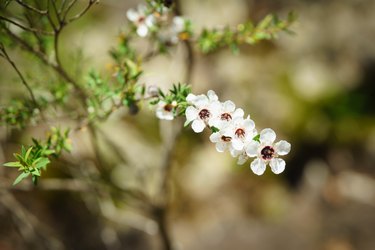
Also known as the broom tea tree and manuka myrtle, the manuka tree (Leptospermum scoparium) is a small evergreen tree native to Australia and New Zealand. The manuka tree is hardy in U.S. Department of Agriculture plant hardiness zones 9 and 10. Therefore, it can only be grown outdoors in the southernmost regions of the continental United States and Hawaii. The nectar of the manuka tree is used to make its namesake honey.
Manuka Tree Identification
Video of the Day
Though often referred to as a tree, the manuka plant is typically more of a shrub, as it has a maximum height between 6 and 10 feet with spreads of the same size. In some cases, it can reach a height between 15 and 20 feet, however. This plant has tough, needlelike leaves that are very aromatic when they are crushed.
Video of the Day
The manuka tree flowers in June and July, producing showy flowers along its woody stems. The flowers of the species manuka plant are cup-shaped and white. Bees are very attracted to manuka flowers. In fact, the manuka plant is best known as the source of the nectar used to make what is known as manuka honey, which is said to have antibacterial properties and is used in a variety of skin and hair care retail products. Once the flowers drop from the plant, they are replaced by woody capsules filled with seeds that may remain on the plant.
Manuka Tree Cultivars
While species manuka trees have white flowers, there are many cultivars available on the market with blooms in shades of pink and red. The 'Burgundy Queen' cultivar, for example, has burgundy double flowers, while the blooms of the 'Silver and Rose' cultivar have rose-pink petals and a green center. The 'Ruby Glow' cultivar has bright red flowers. The 'Snow White' cultivar has double-white flowers with a green center.
In some parts of the Hawaiian Islands, the species manuka tree has become invasive. If this is a concern where you are located, consider growing one of the double-flowered cultivars, which produce relatively few seeds and are therefore less likely to become weedy.
Growing Manuka Trees
A manuka tree will grow best in soil that is fertile and has an acidic pH. This plant grows best in full sun but can handle some shade. The species manuka tree can be grown from seed. However, manuka plant cultivars will not come true from seed and can only be propagated using cuttings.
When choosing a spot for a manuka plant, keep in mind that good drainage is essential for manuka plants, which can succumb to root rot in heavy, waterlogged soils. Young plants need more water than established plants, which have some drought tolerance, making them a good choice for dry climates and rock gardens.
Manuka trees have few pests or diseases of concern. These trees should be pruned every year after the plant is finished flowering. This helps to keep the plant's bushy appearance. If you live outside of the manuka tree's hardiness range, you can grow your manuka bush in a container and overwinter the plant indoors.